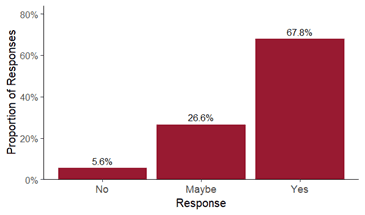We are seeing steadily increasing interest and use of artificial intelligence (AI) among I-O psychologists across the science and practice spectrum, evidenced in part by the numerous well-attended AI-related sessions at the SIOP Annual Conference in recent years. Given this surge in interest in all things AI among I-O psychologists, the SIOP Membership Committee partnered with researchers Steven Zhou (assistant professor at Claremont McKenna College) and Bharati Belwalkar (senior researcher at American Institutes for Research) to specifically understand the impetus and inhibitors of using generative AI (GenAI) in I-O psychology research and practice.
A survey of SIOP members was conducted in November and December 2024, in which participants were asked questions about their familiarity with and use of GenAI, reasons for not using GenAI, and attitudes toward use and teaching of GenAI. Additionally, the survey included questions on the specific use cases of GenAI in academic and applied consulting settings as well as perceived benefits and challenges of this technology. Readers can browse the full results of the survey data—along with the survey questions used—at Zhou and Belwalkar’s dashboard publicly available here.
The survey garnered 483 responses across academic and practitioner SIOP members and was fairly representative of the SIOP member community. To get a sense of the demographic makeup of our members, please log in to the SIOP website and view the SIOP Member Dashboard.
GenAI in I-O Psychology Today
An overwhelming majority of the survey respondents reported using GenAI. More than 90% reported using GenAI at least once a month, and more than half of the participants reported using GenAI at least once a week (see Figure 1). Among those who used GenAI at least once for their work, the vast majority listed increased efficiency and productivity as the primary benefit (see Figure 2). Other perceived benefits include enhanced creativity, higher quality of outputs, and valuable insights and analysis.
Figure 1. Frequency of Use of GenAI Across All 483 Participants

Figure 2. Benefits of Using GenAI

On the flip side, the biggest concern among GenAI users was the accuracy of GenAI output, whereas privacy, copyright, fairness, and bias were also top of mind for some. To some extent, lack of understanding of GenAI technology or expertise in using it was also cited as a challenge. See Figure 3 for more information.
Figure 3. Challenges With Using GenAI

About 45% of the respondents were academics and about 55% practitioners. Hence, we were able to get a fairly good sense of the activities for which people used GenAI in both settings. The top academic activities for which people use GenAI are brainstorming or generating research ideas, summarizing research articles, and reviewing and editing manuscripts. Other popular academic uses included finding research articles or generating code for analysis. Practitioners, on the other hand, reported using GenAI most often to draft or write emails and agendas, draft surveys and focus group questions, and create resources such as checklists, trainings, guides, and so on. See Figures 4 and 5 for more information on the activities.
Figure 4. Proportion of Participants Using GenAI for Academic Research

Figure 5. Proportion of Participants Using GenAI for Applied Practice/Consulting

The few members who reported never using GenAI in their work (i.e., less than 10% of the respondents) cited privacy and legal issues (e.g., copyright) related to uploading data to the AI engine as the primary reason for this; concerns related to quality and/or accuracy of GenAI output were a close second. Interestingly, concerns regarding the quality and accuracy of GenAI outputs were expressed far more by those who use this technology compared to those who do not.
Interestingly, there were notable differences in GenAI usage based on respondents’ occupations. Students reported the highest frequency of use, with about two thirds indicating they use GenAI every few days or daily. In contrast, faculty members and applied researchers reported the lowest usage rates, with slightly less than half using it every few days or daily. Respondents working in external and internal consulting fell between these groups, with more than half of them reporting frequent use. Figure 6 shows the average frequency of use across all groups of participants. Note that there was no other evidence of differences in GenAI usage among other groups, such as education level, SIOP membership status, or age.
Figure 6. Differences in Frequency of Use by Occupation

Note: Frequency was measured on a six-point Likert-type scale with the following anchors: 1 = never, 2 = once a month or fewer, 3 = every few weeks, 4 = once a week, 5 = every few days, and 6 = every day. Additional details on which LLMs were used most frequently are available on the Tableau dashboard.
Future of GenAI in I-O Psychology
Overall, SIOP members seem to have a generally positive outlook for GenAI in the field of I-O psychology. The vast majority (about two thirds) expressed feeling generally positive about the overall impact of GenAI in I-O psychology work and said that they plan to increase their use of this technology in their work (both academic and applied). Less than 5% had a negative outlook (Figure 7) with no plans to use GenAI (Figure 8) in their work.
Figure 7. Overall Impact of GenAI on I-O Psychology

Figure 8. Plans to Increase Use of GenAI in the Future

Consistent with our findings regarding GenAI usage, there were meaningful differences in these perceptions based on respondents’ occupations. Faculty members and applied researchers tended to rate the overall impact of GenAI on I-O psychology less positively than respondents from other occupations. Although more than 75% of external consultants, internal consultants, and students indicated that GenAI has had a positive or very positive impact on the field, only 52% of faculty and 61% of applied researchers agreed. Similarly, only 55% of faculty said they planned to increase their use of GenAI technology in the future, compared to more than 70% of internal and external consultants.
In Conclusion
Collectively, our findings suggest a difference in perceptions and usage between scientists and practitioners, alongside notable enthusiasm among students, who may constitute an emerging group with a distinct outlook on GenAI’s impact. Although it is not possible to ascertain what is driving these differences without further study, one reason might be that the current capabilities of GenAI make them differentially useful depending on the task at hand.
For example, current GenAI tools are better suited to processing text as opposed to analyzing data and are known to hallucinate (produce erroneous results) on occasion, limiting their use to certain tasks. Accordingly, our data suggest that the acceptance of GenAI as a support tool in research/academia has met with more skepticism than in practice.
Regardless of their perceptions or opinions regarding GenAI, it is no surprise that I-O psychologists are embracing the technology. Several respondents made comments such as “GenAI is here to stay” and “I-O needs to stay relevant” and agreed that GenAI should be taught in I-O psychology programs. However, respondents did leave us with a word of caution and caveats on the fair and ethical use and teaching of AI. A strong underlying theme that emerged was that AI technologies should be used in conjunction with I-O psychology knowledge, not as a substitute or to offset the lack of expertise.
Volume
63
Number
2
Author
Monisha Nag, Desmond Leung, Steven Zhou, and Bharati Belwalkar
Topic
Artificial Intelligence (AI), Membership

